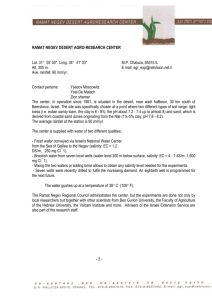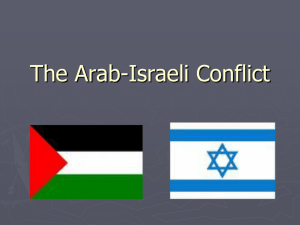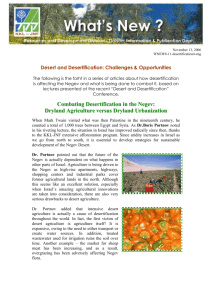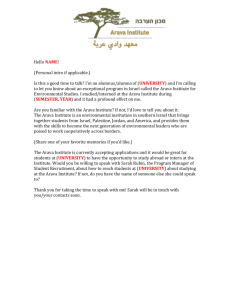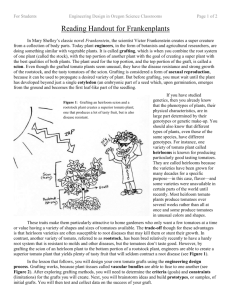Irrigating with Saline Water
advertisement
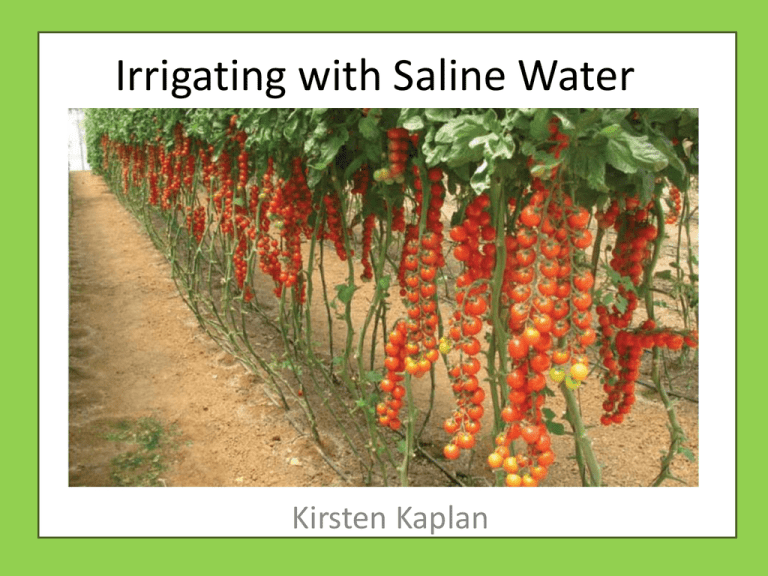
Irrigating with Saline Water Kirsten Kaplan Agriculture in Israel • In 2010, 42% of Israel’s exports ($2.13 billion) were agricultural • 60% of fresh vegetable exports come from Arava region (in Negev desert) • In 2011 1,189 million cubic meters (mcm) of water was used in agricultural production • 680 mcm was recycled and brackish water • Water is a major issue in Israel and the Middle East, so increasing the use of marginal water is important • In the Arava region (in Negev desert): drip irrigation, greenhouses, irrigation with saline water Challenges for Irrigation with Saline Water • Irrigating with saline water requires a unique approach • Salty water makes it harder for plants to take in water – Salt gradient between water and intracellular fluid is reduced – If saline water is sprayed directly on leaves, can cause leaf damage – If water is too salty, osmosis can actually be reversed and water will be pulled out from plant cells • Plant then looses moisture and enters a state of extreme stress • To effectively irrigate with brackish water, Israel turned to grafting – Use rootstocks that are better adapted to regulating the transport of excess salt ions – With certain grafted roots, can get an 80% increase in yield Grafting • Grafting essentially involves taking the scion (bud or shoot) of one plant and attaching it to the rootstock of another • For tomatoes, this process involves growing two different varieties of tomatoes, cutting the stem of both plants when each has about 2 sets of leaves, and attaching the scion and rootstock of the two plants together using a silicon clip – Takes about 5 weeks from planting the seeds until plants are successfully grafted and ready to be moved to the field Grafted tomato plant Success with Saline Irrigation • Israel developed the Desert Sweet tomato, which is irrigated with saline water – This tomato is actually sweeter than other tomatoes! – How does that work? The salt changes the osmolarity of the water, which stresses the plant/plant cells causing them to produce more sugars – Israel has achieved similar results with sweet peppers and melons • Negev farmers have been able to time their peak growing seasons between typical peak growing seasons – Allows them to export and sell fresh produce at a higher price, especially in Europe – The higher price is important to compensate for higher water prices in Israel/the Negev and the increased distance between the site of production and the market Works Cited • Bringing water to the desert. Jewish National Fund. http://www.jnf.org/work-we-do/ourprojects/research-development/bringing-water-to-the-desert.html • Brown, A. S. 2011, April 27. Hidden water holds the key to a changing desert. Inside Science. http://www.insidescience.org/content/hidden-water-holds-key-changingdesert/1234 • Byczynski, L. 2011, March. Grafted tomatoes: worth the trouble? Growing for Market. http://www.growingformarket.com/articles/Grafted-Tomatoes • Cross, N. 2001. Using saline water for irrigation. Primary Industries Agriculture. http://www.dpi.nsw.gov.au/agriculture/resources/soils/salinity/crops/saline-irrigation • Edelstein, M. and M. Ben-Hur. 2011. Grafting to prevent contaminants’ penetration into vegetable plants. Israel Agriculture. http://www.israelagri.com/?CategoryID=396&ArticleID=627 • Estan, M. T., Martinez-Rodriguez, M. M., Perez-Alfocea, F., Flowers, T. J. and M. C. Bolarin. 2005. Grafting raises the salt tolerance of tomato through limiting the transport of sodium and chloride to the shoot. Journal of Experimental Botany 56(412): 703-712. • Garrett, A. 2011. Grafting vegetables- is it worth the trouble? Many growers say yes. Small Farms, Oregon State University. http://smallfarms.oregonstate.edu/sfn/su11graftveg • Moisa, S. (ed.). Israel’s Agriculture. The Israel Export and International Cooperation Institute. http://www.moag.gov.il/agri/files/Israel's_Agriculture_Booklet.pdf
